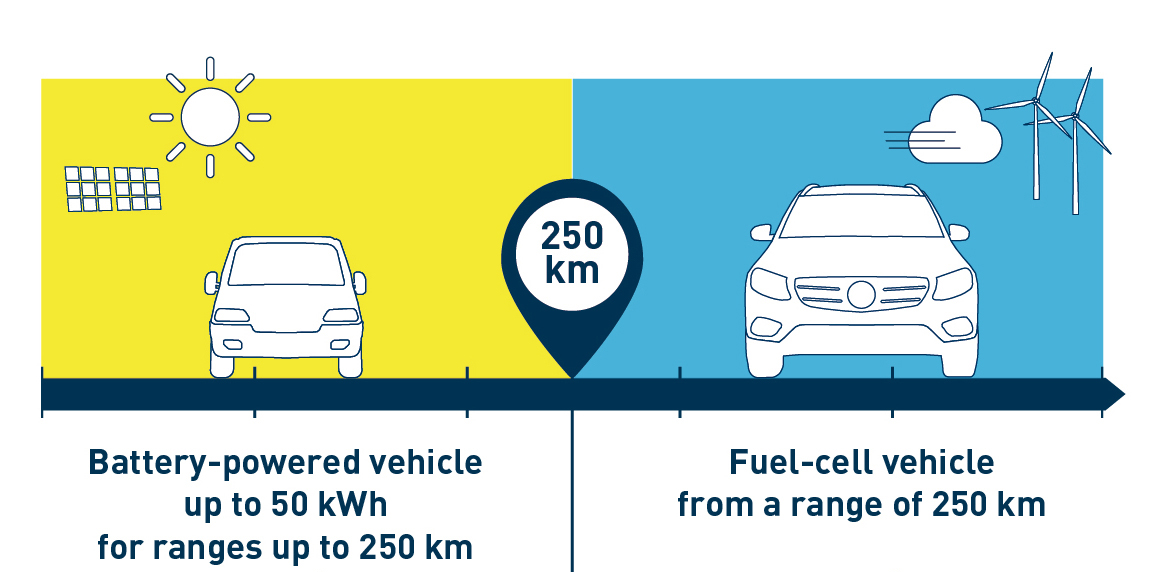
Freiburg/Berlin, 14 Jul 2019 | The results of the life-cycle comparison of longer-range electric vehicles are clear: cars with hydrogen and fuel cells (FCEV) are more climate-friendly than battery-powered vehicles (BEV) if their range is 250 kilometres or more. The decisive factor is the much larger CO2 ‘backpack’ that battery cars have to carry: the emissions caused by the production of the battery.
The study examined the greenhouse gas emissions (GHG) generated during the manufacture, operation and disposal of battery and fuel-cell vehicles with ranges of 300 kilometres and more, for the periods 2020-2030 and 2030-2040. The values were also compared with those of diesel-powered passenger cars.
In their study, the researchers at the Fraunhofer Institute for Solar Energy Systems ISE created a detailed breakdown of how much material is needed for the production of batteries, fuel cells and hydrogen tanks, and what emissions are generated during its production and processing.
The result: The GHG footprint of the production and recycling of a fuel-cell system including tank corresponds approximately to that of an electric drive with a 45-50 kWh storage capacity. For cars with larger batteries, more GHG are emitted than for the fuel-cell system in a comparable power class.
In operation, the source for the electricity and hydrogen is crucial. Following the assumptions of the study published by the Berlin think tank AGORA Verkehrswende, the Fraunhofer ISE assumed solar power (charging at home) as the optimum for the battery car. In the best-case scenario for hydrogen, this is generated from 100% wind energy. However, emissions generated during charging were also compared for the German electricity mix, mixed-case hydrogen production (50% natural gas, 50% wind power), and the worst case: 100% natural gas.
Assuming a total [lifetime] mileage of 150,000 kilometres, the fuel-cell vehicle prevails across the board: Even in the worst case (100% H2 from natural gas), the GHG footprint over its entire lifecycle will still be below that of comparable battery vehicles for the next 10 years, and also lower than that of diesel vehicles.
Conclusion
The study delivers proof of the complementarity of batteries and hydrogen. Vehicles with medium to small batteries (< 50 kWh storage capacity) and ranges of up to 250 kilometres reduce emissions during operation. And from a climate-protection perspective, fuel-cell vehicles have increasing advantages for longer ranges. Both for batteries and for hydrogen: the greener the energy source, the better their environmental score.
The Fraunhofer ISE study was funded by H2 MOBILITY Germany.
Sources in the field of battery electric mobility include ‘Life Cycle Assessment of a Lithium-Ion Battery Ellingsen’ by Majeau-Bettez, Singh, Srivastava, Valøen and Strømman (2014), the study by Agora Verkehrswende (2019), and the Battery department at the ISE.
Sources in the field of fuel-cell vehicles include ‘Integrated environmental and economic assessment of current and future fuel cell vehicles’ by Miotti, Hofer und Bauer (2017), and the expert opinions of the fuel-cell department at the ISE.
PPT_Fraunhofer Study_H2 MOBILITY_Summary (PPT)
ISE_Ergebnisse_Studie_Treibhausgasemissionen (German)
PRESS ENQUIRIES:
H2 MOBILITY Deutschland: Sybille Riepe, +49 (0)170 58 70 317, riepe@h2-mobility.de
Fraunhofer ISE: Karin Schneider M. A., +49 (0)761 45 88 51 50, karin.schneider@ise.fraunhofer.de